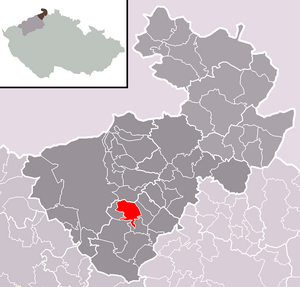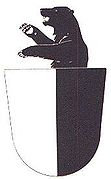Benešov nad Ploučnicí
| Benešov nad Ploučnicí | ||||
|---|---|---|---|---|
|
||||
| Basic data | ||||
| State : |
|
|||
| Region : | Ústecký kraj | |||
| District : | Děčín | |||
| Area : | 977.1932 ha | |||
| Geographic location : | 50 ° 44 ' N , 14 ° 19' E | |||
| Height: | 210 m nm | |||
| Residents : | 3,716 (Jan 1, 2019) | |||
| Postal code : | 407 22 | |||
| License plate : | U | |||
| traffic | ||||
| Railway connection: |
Děčín – Jedlová Benešov – Česká Lípa |
|||
| structure | ||||
| Status: | city | |||
| Districts: | 2 | |||
| administration | ||||
| Mayor : | Filip Ušák (as of 2018) | |||
| Address: | Náměstí Míru 1 407 22 Benešov nad Ploučnicí |
|||
| Municipality number: | 562351 | |||
| Website : | www.benesovnpl.cz | |||
| Location of Benešov nad Ploučnicí in the Děčín district | ||||

|
||||
Benešov nad Ploučnicí (German Beneschau or Bensen ) is a small town in Okres Děčín , Ústecký kraj , Czech Republic .
geography
Geographical location
The city is located in northern Bohemia on a gentle hill in a by Ploučnice ( Polzen ) flowed through the valley on the right bank. To the south of the city is the mountain Kohout (Hahnbusch) , which can be reached from Terezínské Údolí ( Theresiental ) via a hiking trail.
Community structure
The town of Benešov nad Ploučnicí consists of the districts Benešov nad Ploučnicí ( Bensen ) and Ovesná ( Habendorf ), which also form cadastral districts. The basic settlement units are Benešov nad Ploučnicí-střed, Českolipská, Ovesná, Pod Ovesnou, Sad Míru, Sídliště, Táborský vrch, Terezínské Údolí ( Theresienthal ), U hřkolipská, U hřbitova, U koupolyšté žny, U koupolyšté ž, U hřbitova and názdé ž, U koupolyšted, Uškališté, Uškali and názdra.
Neighboring communities
To the south in the Polzen valley is the village of Františkov nad Ploučnicí ( Franzenthal-Ulgersdorf ) with the ruins of Scharfenstein Castle .
history
The place was probably created around 1230 on a trade route leading from Prague over the Elbe Valley to Lausitz at the confluence of the Bystrá brook in the Ploučnice (German Polzen ). The place was first mentioned in a document in 1283. The parish church of the Birth of Mary appears as such in documents from 1384, 1409 and 1416. In 1392 it was granted city rights . In 1426 the Hussites destroyed much of the city and murdered half of the population.
In 1515 the town passed from the property of the Trčka von Lípa to the von Salhausen family, who came from the Meißen region . This began the heyday of urban development. The new city lords had two castles built: the Upper Castle in the years 1522–1524, the Lower Castle in 1540–1544. Both are considered particularly valuable Renaissance monuments.
Since 1562 the town belonged partly to the dominions of Bensen and Binsdorf . The Bensen share was acquired by the Counts of Thun-Hohenstein in 1631 and the Binsdorf part was given to Johann Markus von Aldringen , the Bishop of Seckau , in 1634 . Another division took place under the heirs of Aldringens , so that Bensen belonged to four different owners in 1654. The expansion of the road network around 1820/30 increased the importance of Benešov as a trading place and from 1828 onwards favored the settlement of the textile industry. In 1869 the city received a rail connection through the Bohemian Northern Railway and subsequently developed into an industrial location.
Until 1945/46, the city was mainly populated by Germans. After the First World War , Bensen was added to the newly created Czechoslovakia in 1919 . Due to the Munich Agreement , Bensen belonged from 1938 to 1945 to the district of Tetschen-Bodenbach , administrative district of Aussig , in the Reichsgau Sudetenland of the German Empire . After the end of the Second World War , the region was taken over by Czechoslovakia. The German-speaking population was subsequently expropriated and expelled . Today around 4,000 people live in the city.
Population development
Until 1945, Bensen was mostly populated by German Bohemia , which were expelled.
| year | Residents | Remarks |
|---|---|---|
| 1830 | 1066 | in 225 houses |
| 1900 | 3426 | German residents |
| 1930 | 4150 | including 167 Czechs |
| 1939 | 4077 |

| year | 1970 | 1980 | 1991 | 2001 | 2003 |
|---|---|---|---|---|---|
| Residents | 3 630 | 4,758 | 4 233 | 4 062 | 4 043 |
Twin cities
-
 Heidenau , Saxony
Heidenau , Saxony
Culture and sights
- Bensener palace complex
- Upper Castle - built by Benedikt von Saalhausen in 1522–1524
- Lower castle consisting of 3 buildings:
- Upper building - Johann or Anton Castle (Janův palác / Antonínův palác) - built by Friedrich von Saalhausen in 1540–1544 for his son Johann von Saalhausen, later owned by Anton von Saalhausen
- Medium-sized building - Wolf's Castle (Wolfův palác) - built by Johann von Saalhausen for his son Wolf in 1570–1576, later owned by Anton von Saalhausen
- Černín-Morzin Castle (Černínský palác / Morzinovský palác) - - 1878 for Countess Aloisia lower construction Czernin rebuilt
- Mansions, east of the Upper Castle
- Starschedel House (Starschedelovský dům) - originally a farm building (Hospodářská budova), converted into a mansion under Marie Starschedel in 1583
- Schönfeld House (Schönfeldovský dům or Ballamský dům) - built in the 16th century, rebuilt in 1615 in the Renaissance style
- Konojedsky House (Konojedovský dům) - built in 1552 by Valentin Hirsch from Annaberg , later named after the Konojed reign
- Church of the Birth of Mary
- Holy Trinity Chapel
- St. Hubert Museum and Gallery (Kostelní ul. 270)
- Statue of Saint John of Nepomuk
- Statue of Saint Adalbert
- Statues on the Calvary (on the road to Bohemian Leipa / Česká Lípa )
- Marian column
- Linden von Bensen - a natural monument (behind the church on the road to Ovesná (Habendorf), trunk circumference 315–345 cm)
Personalities
- Franz Xaver Huber (1755–1814), Austrian journalist, satirist and librettist
- Theodor Grohmann (1844–1919), Austrian industrialist, large landowner, councilor and patron
- Joseph Willomitzer (1849–1900), German journalist in Prague
- Karl Hossinger (1904–1985), German administrative lawyer and politician (KPD, SED)
- Kurt Pscherer (1915–2000), Austrian theater director and director
- Fritz Möser (1932–2013), German artist
- Roland Ducke (1934-2005), German football player
- Peter Ducke (* 1941), German soccer player
- Frieder Wagner (* 1942), German filmmaker and recipient of the Grimme Prize 1981 and the European Television Prize of ÖKUMEDIA 2004
Web links
- http://www.benesovnpl.cz
- Information on the development of Benešov
- http://www.historiebnpl.cz/ - history
Individual evidence
- ↑ http://www.uir.cz/obec/562351/Benesov-nad-Ploucnici
- ↑ Český statistický úřad - The population of the Czech municipalities as of January 1, 2019 (PDF; 7.4 MiB)
- ↑ http://www.uir.cz/casti-obce-obec/562351/Obec-Benesov-nad-Ploucnici
- ↑ http://www.uir.cz/katastralni-uzemi-obec/562351/Obec-Benesov-nad-Ploucnici
- ↑ http://www.uir.cz/zsj-obec/562351/Obec-Benesov-nad-Ploucnici
- ↑ Jaroslaus Schaller : Topography of the Kingdom of Bohemia . Volume 5: Leutmeritzer Kreis , Vienna 1787, pp. 268–269, item 1).
- ^ A b Johann Gottfried Sommer : The Kingdom of Bohemia . Volume 1: Leitmeritzer Kreis , Prague 1833, pp. 299-300.
- ↑ Yearbooks of the Bohemian Museum of Natural and Regional Studies, History, Art and Literature . Volume 2, Prague 1831, p. 197, paragraph 23 below.
- ^ Meyers Großes Konversations-Lexikon 6th edition, Volume 3, Leipzig and Vienna 1905, p. 639 .
- ^ A b Michael Rademacher: German administrative history from the unification of the empire in 1871 to the reunification in 1990. Tetschen district (Czech: Decín). (Online material for the dissertation, Osnabrück 2006).
- ^ Genealogy Sudetenland
- ↑ Czech population statistics




